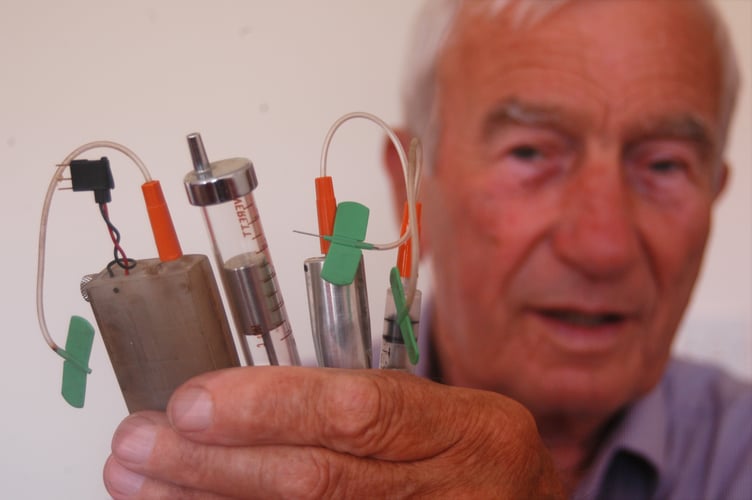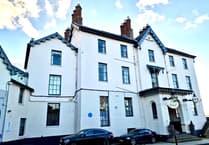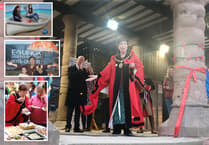AN inventor who has helped save the lives of hundreds of thousands of people suffering from diabetes, has been awarded with an honorary degree.
Robert Channon from Walford, received an Honorary Doctor of Engineering degree by the University of the West of England in Bristol in recognition of his pioneering work that changed the administration of insulin during the 1970s and 1980s.
Mr Channon’s remarkable career began with the development of the first programmable insulin pump, allowing different rates of insulin infusion to be dispensed.
Mr Channon set to work on an old lathe in his garden shed where he designed and built the prototype insulin pump driven by a small compression spring that had the ability to deliver different rates of insulin, depending on blood glucose levels.
The compact, battery-powered insulin infusion pump that was developed in 1979 weighed just three ounces.

The design was later refined to allow convenient repeated subcutaneous injections of insulin, which was the forerunner to the Novopen, used today.
Mr Channon’s foundation work made a significant global contribution to the care and management of people with diabetes.

And whilst working in the study of corrosive science, a number of years later, in the company of other scientists, he made a discovery that being the only one in the group who was diabetic, he recorded a meter reading when he held two prongs in close proximity when the others didn’t.
Mr Channon carried out further research into this phenomenon and developed a device that could measure blood glucose levels through the skin.
And by the mid-1990s he had created a glucose monitoring system that when combined with a sensor placed on the arm, a monitor device detects a person’s blood sugar levels, which could also be linked to an infusion pump.
Today the monitor uses smart phone technology which beeps when levels are too high or low.
Politician Teresa May was one of the first to benefit from the commercial release in 1999.
Mr Channon said: “The work I am best known for is in the medical world for diabetes, which is very unusual for a marine engineer. It serves as an example that crossing boundaries and collaborate working can achieve great things and benefits society.
“I have to acknowledge the support of Professor Alan Winfield during my innovative work on the insulin infusion pump.
“The clinical trials took place at Guy’s Hospital in London. My confidence in my invention was such that I strapped the device which I had made in my workshop at home to my abdomen before catching the train to London.
“The effect on my blood glucose levels was amazing. Not only did it keep me alive, but my sugar levels returned to near normal. I am proud that this concept has enhanced the lives of hundreds of thousands of diabetics worldwide.
“Having been told that because of my diabetes, my life expectancy would be around 30 years. I have passed this milestone by some distance, having recently celebrated my 80th birthday.
Mr Channon originally qualified as a marine engineering designer and during his time as an officer in the Merchant Navy he designed the pump room of a ship named the Harry Brown to suck sand from the Bristol Channel.
Mr Channon was also an inventor of a drone prototype. He had been working on unmanned helicopters for the military in a bid to detect landmines.
But there were problems with the original concept, until he changed the two standard rotors and replaced them with four smaller horizontal rotary systems and, “Hey presto, this worked,” exclaimed Mr Channon.
“This had a novel gyroscopic stabilisation system which allowed the vehicle to hover in place without the need for constant attention by a pilot. This was ultimately called the Nitrohawk, which could be equipped with a broadcast quality digital camera and has since been used by the movie industry.
“The penalty of an overactive curiosity is that I have lost many hours absorbed and learning from nature in seeking solutions to seemingly unanswerable problems.”
Mr Channon told the students that were also graduating the same day: “My association with UWE Bristol spans over six decades, as I attended the forerunner of this university and obtained my engineering qualifications. To receive this degree is truly a great honour and an enormous privilege.
“My advice for all graduates and students at the university is that if in doubt, believe in yourself, look closely and scientifically at problems, and postulate how nature resolves them.”
Mr Channon then received a standing ovation for his efforts. After the ceremony a lot of people from the audience then approached him to have their photographs taken with him. One woman even gave him a hug and said that he had effectively saved her daughter’s life.
In 1999 Mr Channon developed an ultrasonic animal warning system for road vehicles to reduce the amount of wildlife death.
Mr Channon said that he observed that whilst driving his Ford RS500 in Exmoor, a turbo charged vehicle, he didn’t hit any animals until the time when the turbo wasn’t working.
“I couldn’t hear the high pitch of the turbo charger, but I realised that these small animals could. I deduced that the whine of the turbo charger must be giving an early warning to animals, and I reproduced the same effect with a simple ultrasonic device.
“Another invention dates back to the mid 1970s era, Mr Channon drops into the conversation.
“A lot of workers were going on strike at this time, which caused numerous problems and in particular the water industry and the sewage network close to Weston Super Mare was not being maintained properly. This resulted in a lot of sewage being deposited on the beach, meaning that the local authority lost its clean bathing status.
“Wessex Water then contracted me to repair the sluice gates and as part of this I developed a screen and a form of a basic robot to help remove the solids from the liquids and prevent the sewage entering the water outlets.”
Mr Channon then reflects on his career and said: “I didn’t realise until I was in my late 20s that I had talent for anything. I just drew things, designed them and made them work. I’ve been doing that for the whole of my life.
“I didn’t take a patent out on most of my inventions. I had intended applying to have a patent on my infusion pump, but I couldn’t make the patients’ wait for it to be approved.
“There were 10 patients undertaking clinical trials in Bristol for what eventually became the Novopen, but I didn’t have the heart to make them wait.
“I’ve effectively donated the patent to the medical field. The industry today makes £1.7Billion a year out of the Novopen.”

Mr Channon then reflected on life in Walford for the past 24 years and said: “I still have a workshop or two and I still manage to spend time tinkering with various projects to this day.
“I still have the machines in my workshop from which I made my inventions. I also have a love of classic cars and I still own an old MG.”





Comments
This article has no comments yet. Be the first to leave a comment.